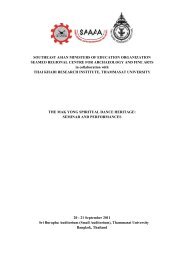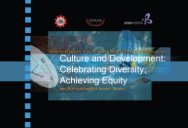- Page 2:
○ ○ ○ ○ ○ ○ ○ ○ ○
- Page 5 and 6:
○ ○ ○ ○ ○ ○ ○ ○ ○
- Page 7 and 8:
ContentsPreface to 2004 Guidelines
- Page 9 and 10:
“Development as it affects a comm
- Page 11 and 12:
10PREFACE TO 2004 GUIDELINES EDITIO
- Page 13 and 14:
Fororeworord:12FororeworordDespite
- Page 16 and 17:
PART ONE15HOW THE GUIDELINES EVOLVE
- Page 18 and 19:
the best of intentions we can not o
- Page 21 and 22:
○ ○ ○ ○ ○ ○ ○ ○ ○
- Page 23 and 24:
○ ○ ○ ○ ○ ○ ○ ○ ○
- Page 25 and 26:
○ ○ ○ ○ ○ ○ ○ ○ ○
- Page 27 and 28:
○ ○ ○ ○ ○ ○ ○ ○ ○
- Page 29:
○ ○ ○ ○ ○ ○ ○ ○ ○
- Page 33 and 34:
32“Tolerance, inter-cultural dial
- Page 35 and 36:
34IntroductionThe first day of the
- Page 37 and 38:
36other groups may share those valu
- Page 39 and 40:
TOPICSWhat do I expect from this wo
- Page 41 and 42:
406. A representative from each gro
- Page 43 and 44:
1.3 Meanings of CultureTime: 90 min
- Page 45 and 46:
4) Culture is the roles and guideli
- Page 47 and 48:
Step 26. The following cultural map
- Page 49 and 50:
Notes on Cultural MappingCultural m
- Page 51 and 52:
50Discussion following this activit
- Page 53 and 54:
Questions ChecklistHas my understan
- Page 55 and 56:
54“We need to find ways of relati
- Page 57 and 58:
56IntroductionFollowing on from the
- Page 59:
58include supporters or opponents o
- Page 62 and 63:
Activity 2.3 - Development CartoonT
- Page 64 and 65:
Activity 2.4 - Tools BrainstormTime
- Page 66 and 67:
2. Invite volunteers to explain bri
- Page 68 and 69:
Activity 2.6 - Enabling & Inhibitin
- Page 71 and 72:
Questions ChecklistWhat is my view
- Page 73 and 74: 72“Mr. Director General, why is i
- Page 75 and 76: 74IntroductionRead the following co
- Page 77: 76redundant because they consider t
- Page 80 and 81: Activity 3.3 The Programme Cycle79T
- Page 82 and 83: COUNTRYCONSULTATIONSEVALUATIONIDENT
- Page 84: What it is and why we use itFirst w
- Page 87 and 88: TERMAssumptionsMEANINGFactors exter
- Page 89 and 90: 88Table 2: Log FrameOBJECTIVESPURPO
- Page 91 and 92: participants when they took the rol
- Page 93 and 94: Avoiding log frame design problems(
- Page 95 and 96: Questions ChecklistHow can I promot
- Page 97 and 98: 96“One of the most difficult thin
- Page 99 and 100: 98IntroductionThe overall aim of Da
- Page 101 and 102: 100Activity 4.5, like 4.3, recommen
- Page 103 and 104: TOPICSHow does the way we represent
- Page 105 and 106: 1044. Ask participants to repeat th
- Page 107 and 108: Activity 4.5 Attitudes and Assumpti
- Page 109 and 110: Activity 4.6 Colleague Card SortSou
- Page 111 and 112: Activity 4.7 Describing a Resourcef
- Page 113 and 114: Questions ChecklistWhat are my pers
- Page 115 and 116: 114“Reconciliation is to understa
- Page 117 and 118: 116IntroductionThroughout the works
- Page 119 and 120: TOPICSWhat is meant by conflict med
- Page 121 and 122: 120maybe without even realizing or
- Page 123: 1223. If necessary, demonstrate. Fo
- Page 127 and 128: Conclusion126Transforming situation
- Page 129 and 130: 128
- Page 131 and 132: ○ ○ ○ ○ ○ ○ ○○ ○
- Page 133 and 134: ○ ○ ○ ○ ○ ○ ○○ ○
- Page 135 and 136: ○ ○ ○ ○ ○ ○ ○○ ○
- Page 137 and 138: ○ ○ ○ ○ ○ ○ ○○ ○
- Page 139 and 140: ○ ○ ○ ○ ○ ○ ○○ ○
- Page 141 and 142: ○ ○ ○ ○ ○ ○ ○○ ○
- Page 143 and 144: ○ ○ ○ ○ ○ ○ ○○ ○
- Page 145 and 146: ContributorsAnuchit Jittrathanakul
- Page 147 and 148: ContributorsVirongrung Bodharamik (
- Page 149: 148For information and enquiries:Ce










